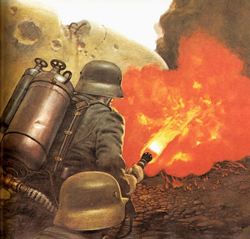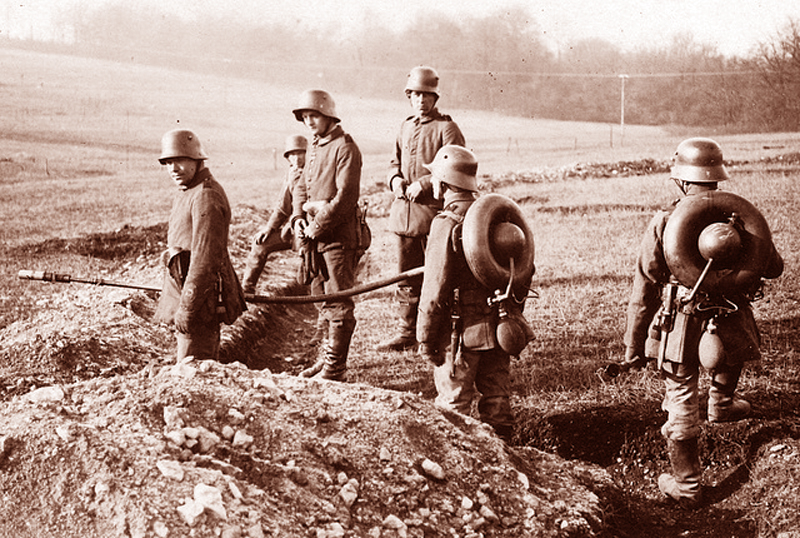1915 DWM Death Head SOLD
PHOENIX INVESTMENT ARMS - PREMIUM COLLECTOR LUGERS
Genuine German Luger - Largest Variety of Lugers Offered
Home | Post WWI DWM | Erfurt Lugers | Mauser | Simson Suhl | Krieghoff | Vickers, Ltd
| Swiss Bern | Other Guns
Bottom of Page
|
|
|
This is a 1915 dated DWM Model 1908 Parabellum that has been inscribed with the early Death Head that has been attributed to the early Storm Troopers, the Flame Thrower soldier, the Werewolfs of the Intra-war period and the early Weimar Freikorp Werewolf units. Much of the legend is antidotal but most is a summation of events.
(1826) |
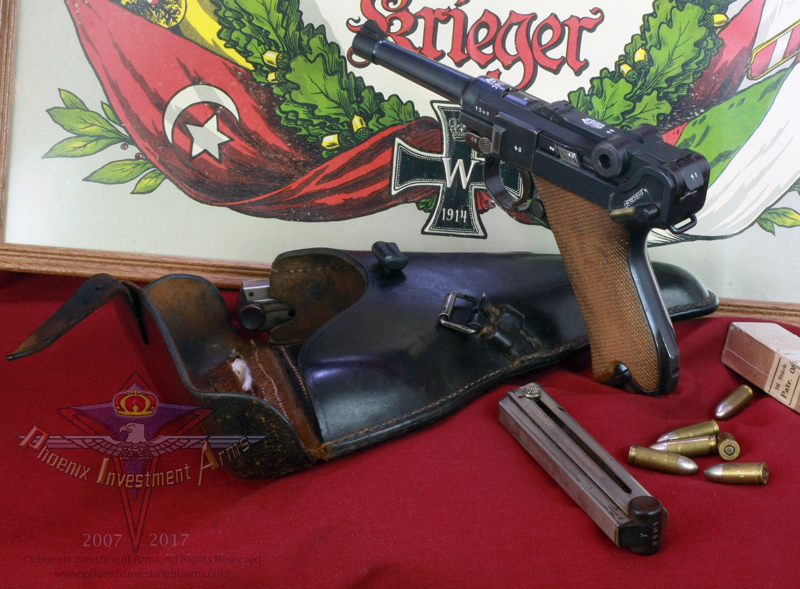 |
|
NOTE: Photographs taken today with the high mega-pixel camera show more than we sometimes can see with the human eye. Magnified close-ups show us tool marks and natural surface conditions that one normally doesn't see in the ordinary handling of the weapon. Photographs are copyrighted, all rights reserved, any extraction, reproduction or display of gun pictures without the express consent of the Phoenix Investment Arms is strictly prohibited. Thank you for your cooperation. Please visit Legal (tabbed) for Conditions of Sale. |
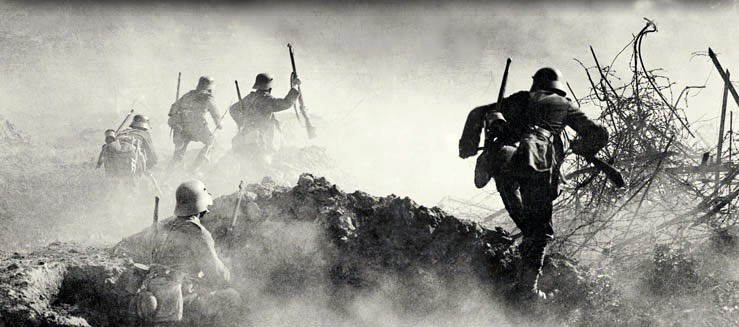 |
|
The Death Head and the Werewolf are ancient myths from the 1100's concept of half-man/half-wolf. The Death Head symbol in the German military as light calvary from the Hungarian Region and led by Field Marshall August von Mackensen. |
|
|
|
At first glance this looks like a standard 1908 Model with the short frame,long sear and marked in the military (exposed) positions. However this Parabellum begins to tell its story as soon as we study it. |
|
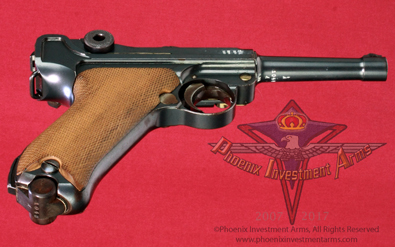 |
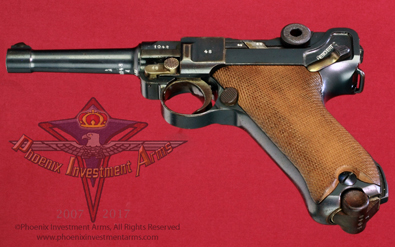 |
This 1915 dated 9mm Parabellum has seen service and is still in excellent condition for a carried handgun with expected wear on the end of the muzzle and side plate. Immediate inspection reveals both the Imperial proofs and commercial proofs. |
|
 |
|
|
|
|
 |
|
This 1915 has all the military markings and Imperial proofs that you would expect from a Parabellum of that period. However it begins to reveal its secrets with an inspection of the barrel. Below Left: We can see that the numbers on the barrel, frame and magazine are all of the same font yet the numbers and suffix on the barrel appear with the halo of a 'struck after blueing'. |
|

|
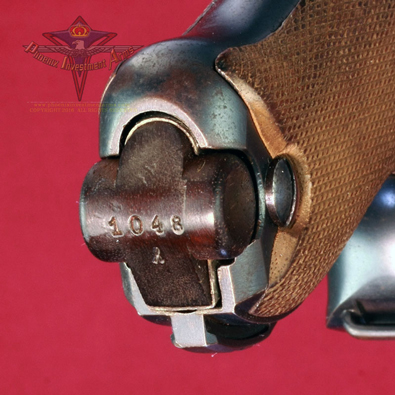
|
|
Above Left: The matching serial number is in the "H"suffix and bears the 8.82 gauge marking. The addition of the Crown "N" proof suggests this was in "re-work" when the war ended and was finished, tested and issued after 1919. There are no export marks on the gun. Above Right: The matching magazine with the suffix "h". The matching magazine with the same font as the gun are in excellent shape and indicate this Parabellum spent a lot of time in the holster and not on the battlefield. |
|
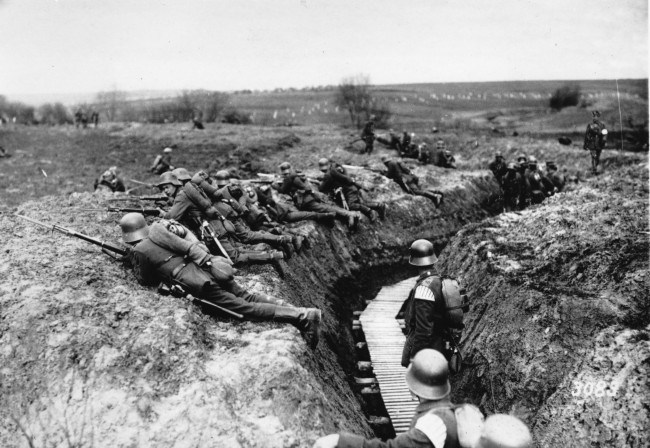
|
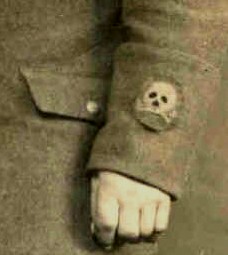 The Death Head introduced during WWI was the full head (skull) with cross bones. Fresh troops, not assigned to any unit were brought in to spearhead the German infantry during the winter of 1914-1915: The Shock troops (Stoßtruppe), fresh infantry groups that were never officially recognized as such and never belonged to any permanent unit, but remained active until the end of the war and contributed improving the offensive capacity of the German infantry. Led by flame throwers with the Kleinflammenwerfer they rushed the opposing lines to punch a hole through which the regular troop flowed. The death's-head continued to be used by Prussian & Brunswick forces until 1918. The Death Head introduced during WWI was the full head (skull) with cross bones. Fresh troops, not assigned to any unit were brought in to spearhead the German infantry during the winter of 1914-1915: The Shock troops (Stoßtruppe), fresh infantry groups that were never officially recognized as such and never belonged to any permanent unit, but remained active until the end of the war and contributed improving the offensive capacity of the German infantry. Led by flame throwers with the Kleinflammenwerfer they rushed the opposing lines to punch a hole through which the regular troop flowed. The death's-head continued to be used by Prussian & Brunswick forces until 1918. |
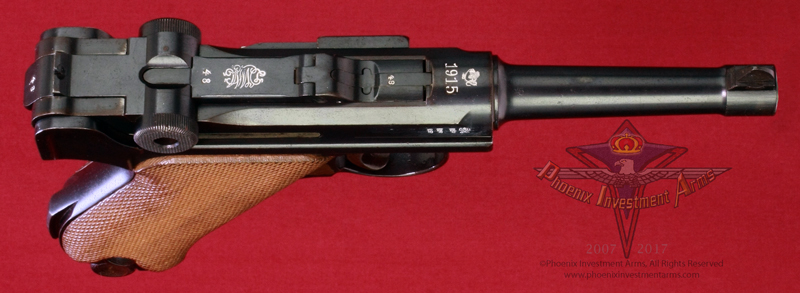 |
|
From research over the years we have learned that deliveries of the Parabellum stopped on or about November 9, 1918 when the German Imperial government abdicated and DWM was in the "k" suffix and "l," was just beginning. They continued production until they ran out of coal in late December and there were approximately 5,000 post-war guns a month being produced. |
|
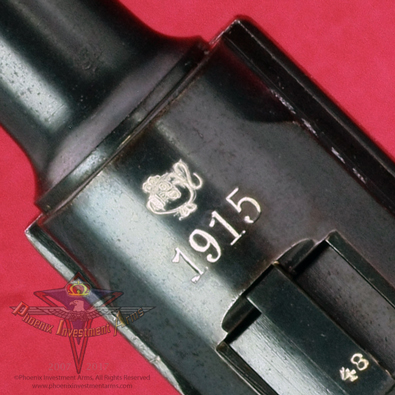 |
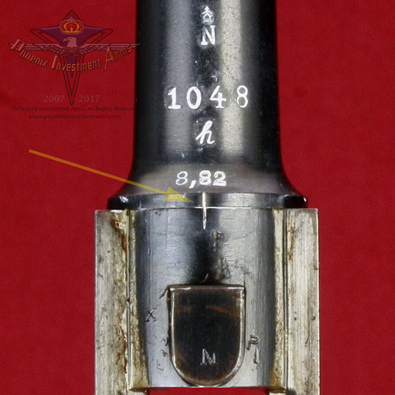 |
Above Left: On can see the Death head inscription with the cross bones behind the head and the lazy "S" above taken by most to represent the flame thrower units. Above Right: So we have an Imperial marked barrel with Imperial numbering but the Crown N commercial proof. Was this a Imperial replacement barrel that was installed after WWI and matched to the gun by DWM? Not only is the alignment strike clean and true but on the slide stop is the "N" which was a early 1915 DWM mark on the stop and in the well of worked guns. |
|
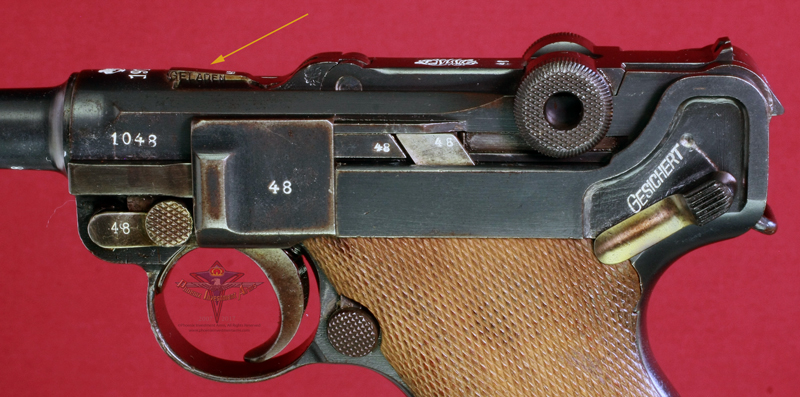 |
|
The Extractor is marked GELADEN [Loaded] which was revolutionary when implemented by Georg Luger to show the gun was loaded both visually or tactilely in the dark. |
|
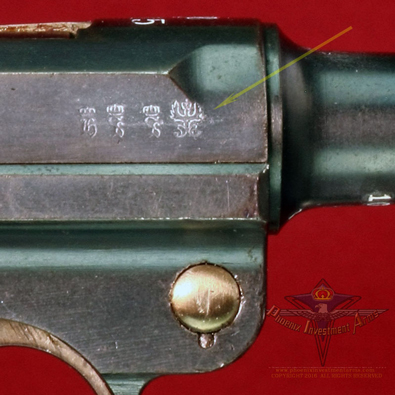
|
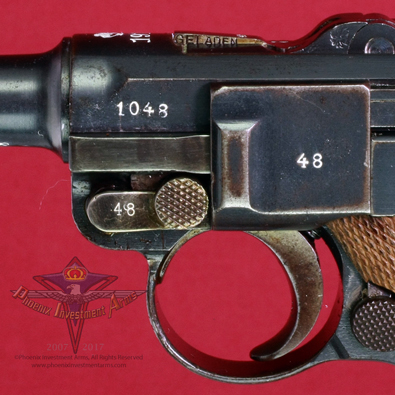 |
The right side of the receiver is marked with three Crown inspection marks and the DWM final proof tells us that this gun was produced and accepted initially during WWI. |
|

|
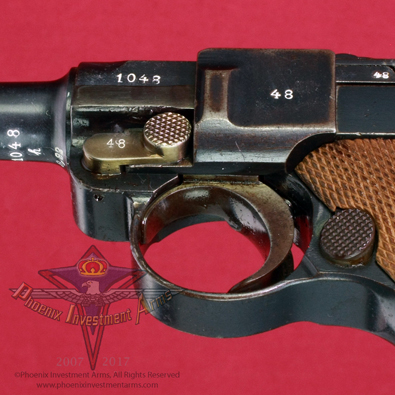
|
Above Left: On the barrel is the acceptance mark of the Imperial military. So we know it was pressure tested by Imperial Inspectors. A close-up of the Death Head shows us that the design is basically rudimentary and not the type of work of either DWM or Erfurt die makers. More probably this was a pantograph that was applied after acquisition and a tradesman provided this service of adapting the insignia. |
|
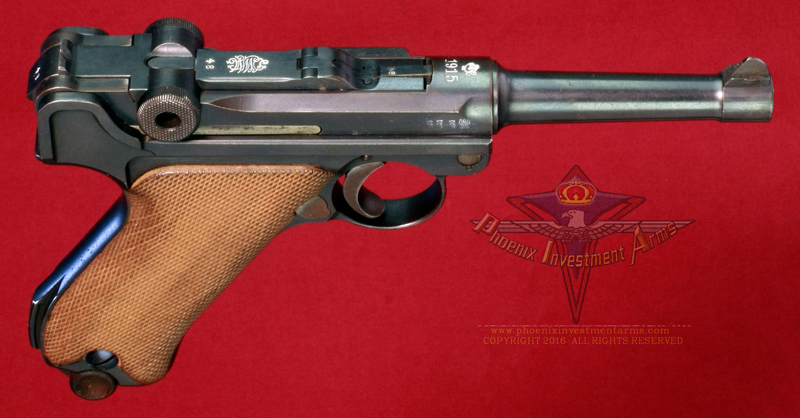 |
|
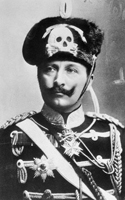 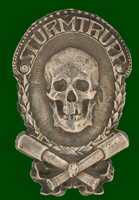 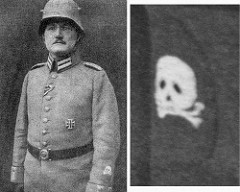
|
Above are pictures of Kaiser Wilhelm wearing the Death Head, the badge of the Storm Troopers, and Captain Willy Rohr who commanded the first Sturmtrupp battalions employing the flamethrower assault forces at Ypres on July 30th, 1915. Below a post war Freikorps unit displaying the Imperial Flag, the Werewolf flag and Death Head sleeve patches.
|
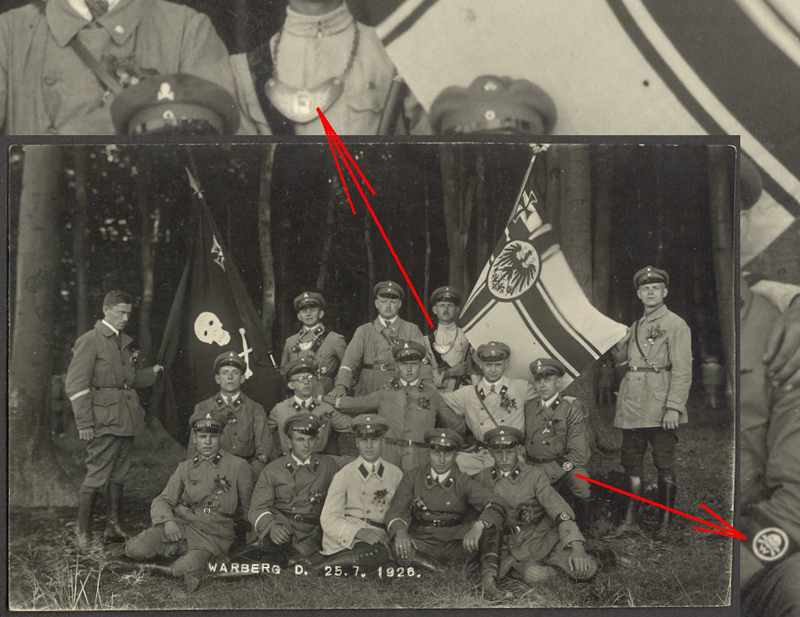 |
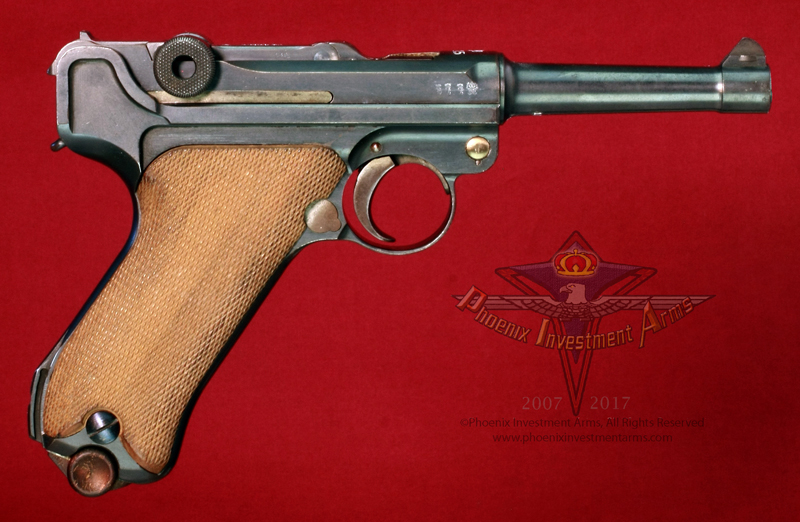 |
|
|
In the interim from the December plant closing until pre-IMKK inspectors in January 20, 1920 Germany was a period of producing as many guns possible with the 100mm barrel from all the parts left over from the Imperial war time production. With a contract for 15,000 Reichswehr (new formed Weimar army) Parabellums and guns for the German police which was a method of non-counting production for the Police. |
|
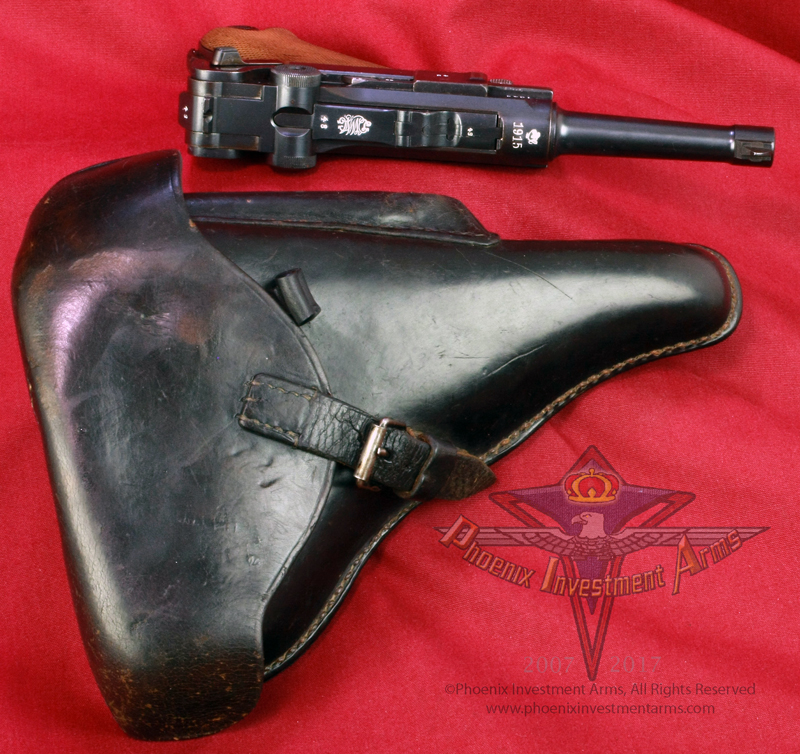 |
|
This offering includes the all matching 1915 Dated early Death Head 9mm Parabellum, two matching silver sleeved matching magazines, a 1915 dated holster with a loading tool and patch strap. |
|
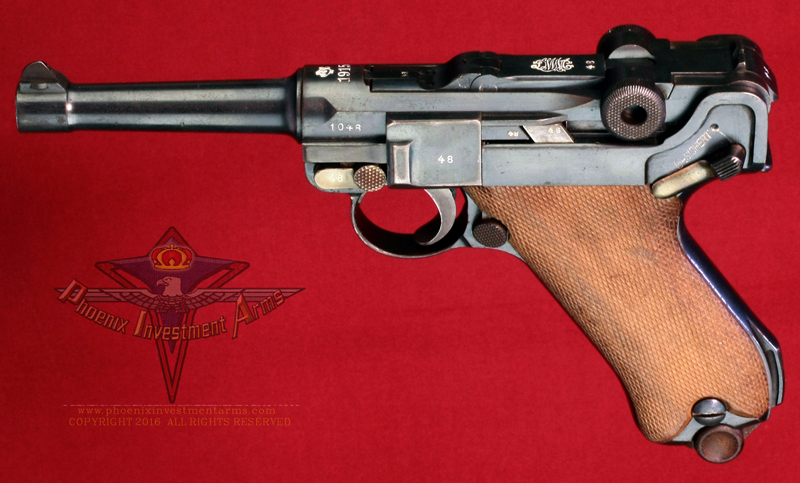 |
|
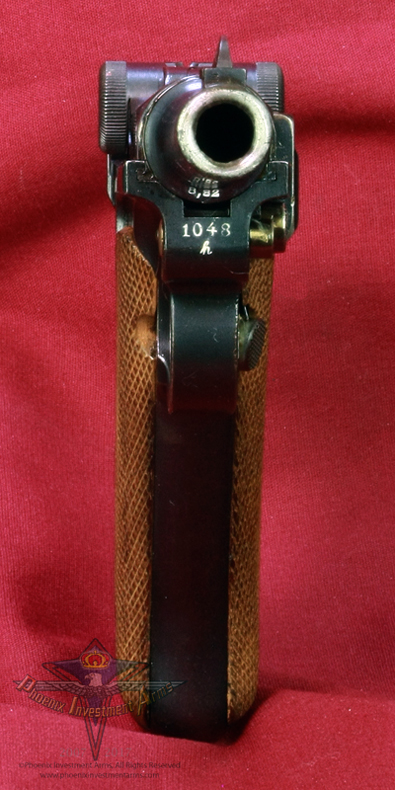
|
 |
|
The front and back of the gun show us a clean and minty front and rear grip strap. Under the rear toggle there are the indent marks showing the gun was employed by firing. |
|
 |
|
The Kleinflammenwerfer (small flame thrower) was developed by the Germans with field testing in 1901. It was employed against the French in 1911 and The first notable use of the Flammenwerfer came in a surprise attack launched by the Germans upon the British at in Flanders, Belgium, on July 30, 1915, during the battle of Hooge. Moving from a static flame thrower to a mobile one gave the Germans the ability to assault with this weapon. This was terrifying but the source of the flame became a bullet magnet for the opposition. |
|
The Germans produced a lightweight modified version of their Flammenwerfer, the Wex, in 1917, which had the benefit of self-igniting. Above Weimar soldiers carrying the Wex Flamethrower and armed with the Parabellum. .
|
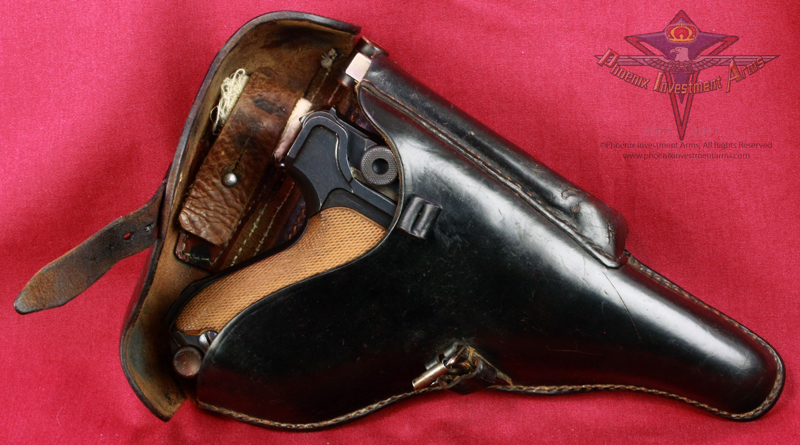 |
|
This is a very unique holster that still bears the original white stitching and is fully functional with intact stitching, pliable straps and functions. It also has an extended strap for the loading tool to accommodate the cleaning patches. Seldom seen and not attributable to any period, it must have been a feature of that holster maker. |
|
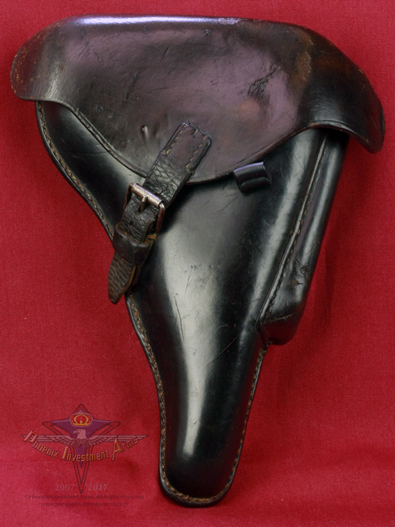 |
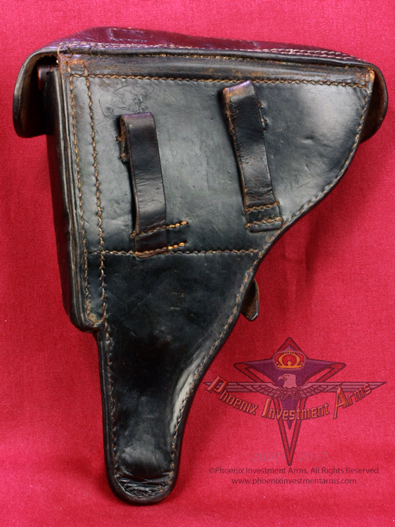 |
| The Front and Back of the holster is in good to very good condition with minimal wear. | |
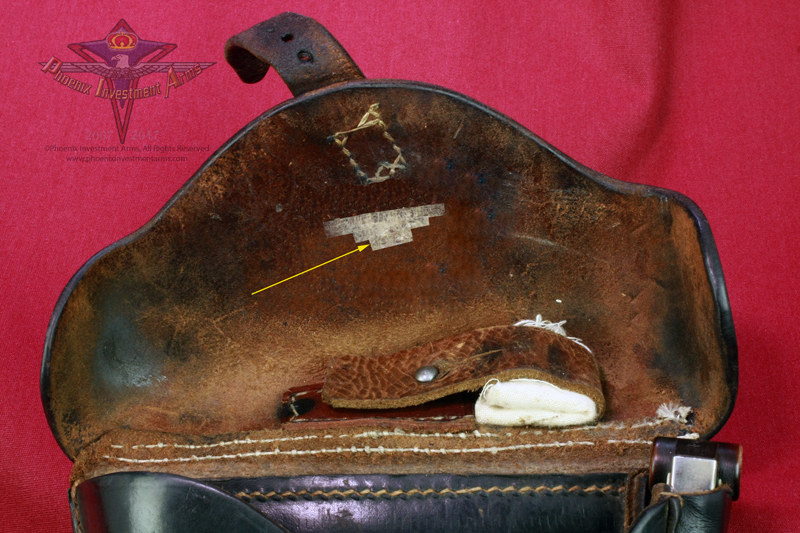 |
|
Inside the flap is the manufacturer's cartouche, Stuttgart, and the date 1915. We can also see the pouch cover that is elongated to accommodate cleaning patches. |
|
 |
|
Also, and at the least unusual, on the back of a dated 1915 holster is an early Waffenamt proof which would tell us that this Luger was sent back for re-working and the weapon and holster were kept together for whatever was done and re-issued during the Weimar era. |
|
With Germany’s defeat after WWI private armies developed amongst returning veterans known as the Freikorps or "Free Corps". These private paramilitary groups first appeared in December 1918 when communists were hoping for a Soviet style revolution. Composed of ex-soldiers, unemployed youth, and other discontents and led by ex-officers and other former military personnel, they proliferated all over Germany in the spring and summer of 1919 and eventually numbered more than 65 corps of various names, sizes, and descriptions. Most were nationalistic and radically conservative and were employed unofficially but effectively to put down left-wing revolts and uprisings in Berlin, Bremen, Brunswick,Hamburg, Halle, Leipzig, Silesia, Thuringia, and the Ruhr. They fought miniature wars and sometimes resorted to plunder and terror.
| |
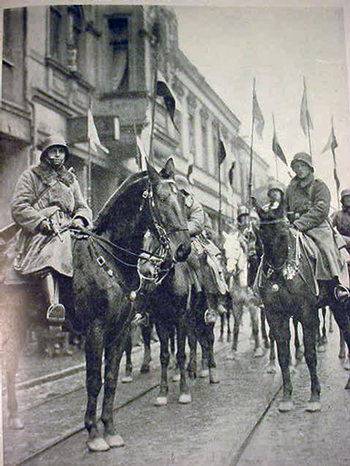
| 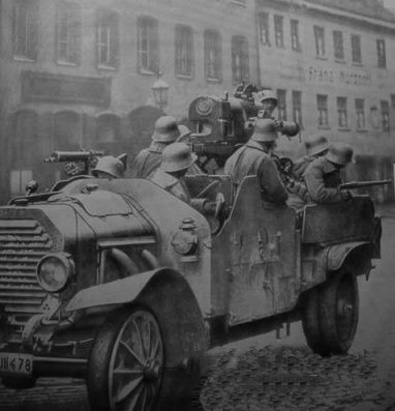
|
These units form paramilitary units adoption various insignia including the most prevalent the death head of WWI and the "W" of the Werewolf units. There is much sentiment that these "rouge" units saved Germany from the post war chaos and imminent take over by Soviet style communism. Originally praised by General Paul von Hindenburg and then tolerated soon declared a nuisance and a threat, and their activities were eventually supplanted by regular army and police work or assumed by the new units of the Nazis and other political parties. As they were assimilated so to were their weapons these veterans brought with them from WWI and post war. | |
 |
|
This Parabellum is in very good condition for having been created in 1915 and then serving in the Weimar Republic and then some, most probably brought back after WWII. A living history. |
|
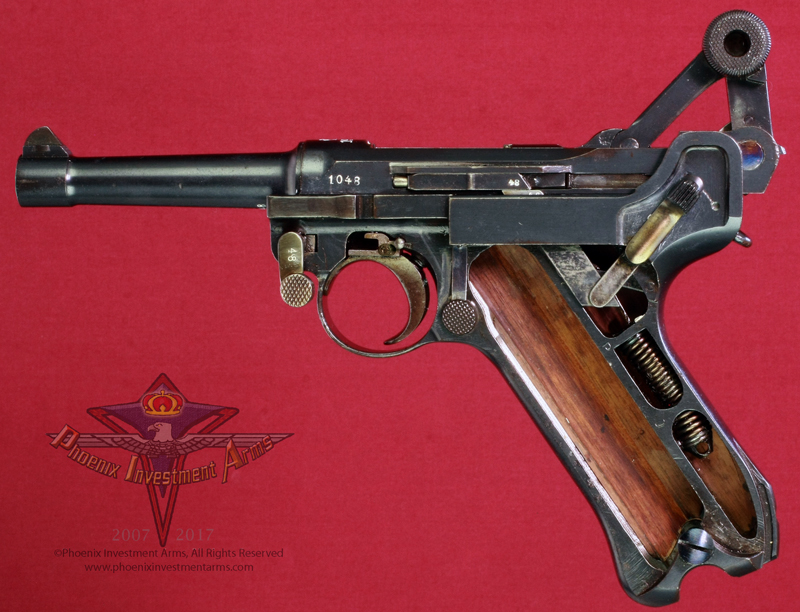 |
|
|
The inside of this Luger shows us the main spring and thumb safety that operates the sear stop. As a pre-1916 model this Parabellum has a long sear that prevents the gun to be cocked while the sear is on safe, important to the user who wants to load a round and still have the security of the thumb safety. |
|
 |
|
The breech block presents another anomaly that takes the gun out of the standard production run with the DWM Imperial Acceptance Proof on the left side and a Crown "N" on the right side. to have both on the same piece is redundant so this must indicate it went in for some re-work after WWI and was proofed for a commercial version. |
|
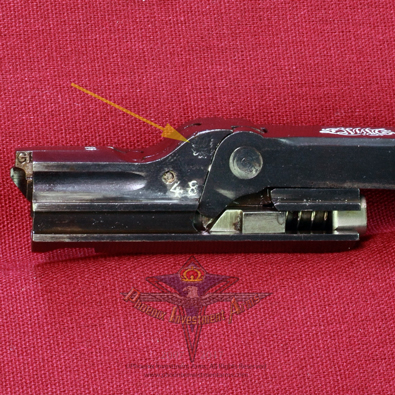 |
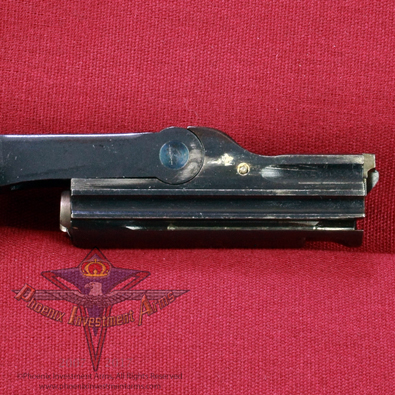 |
On one side of the breech block is again the Imperial proof of DWM and on the right side of the breech block is the Crown N of the commercial proof requirements. This dichogamy illustrates the re-work and re-issue of Lugers after the end of WWI and the 1920's arrival of the Allied Commission to dictate caliber size and barrel lengths. . |
|
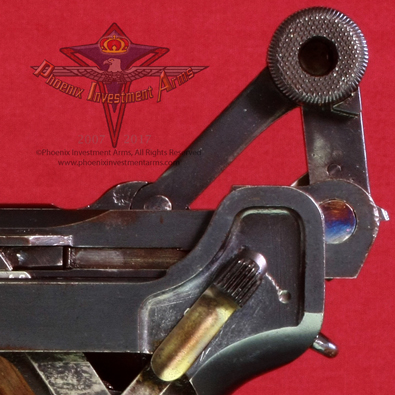 |
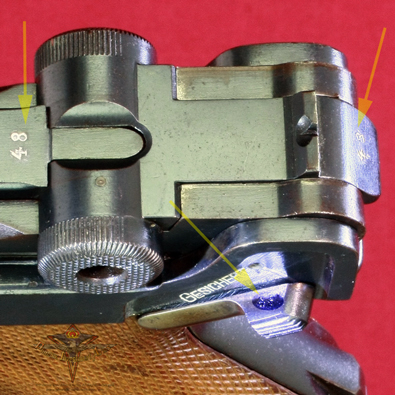 |
Above Left: With the gun in full recoil one can clearly see the DWM Imperial acceptance stamp on the breechblock and the fire blued connector pins. Above Right: The last two digits of the matching serial number is on the top of the thumb safety, on the rear of the 1st & 2nd toggle. |
|
 |
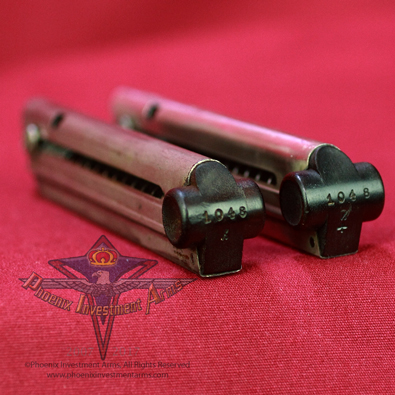 |
The firing pin is the old style that is expected in these 1908 Models with the matching last two digits of the serial number. The magazines are silver sleeved wrapped and crimp metal with the wooden bottom serial numbered to the gun. |
|
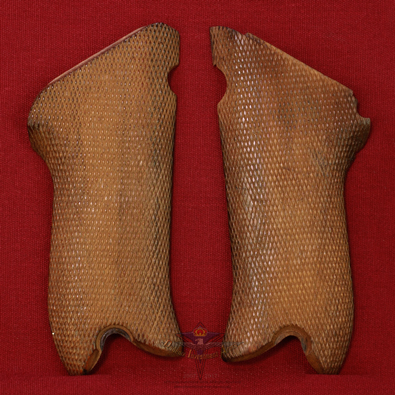 |
 |
| The grips show minor wear on the outside and are serial numbered to the gun on the inside. | |
 |
|
| It is entirely subjective to give any firearm a rating of excellent or fine, just as it is to declare it xx% blued or strawed. Few collectible weapons are out of the box new and these are premium priced. Bluing percentages is like Beauty, in the eye of the beholder. We strive to provide pictures so you can judge for yourself if the gun meets your criteria. Any questions or request for additional purchases email to josef@phoenixinvestmentarms.com. This firearm is eligible for transfer to C&R permit holder, even in California. We are registered with CA DOJ for firearms shipment. | |
 |
On June 28th, 1919,
Germany signed the formal Peace Treaty sealing the previous armistice of
November 11th - this was the well known Treaty of Versailles. According
to the treaty Germany was allowed a standing armed forces of 100,000
men. This new and highly regulated force was to be known simply as the
Reichswehr which was officially formed on January 1st, 1921. It
consisted of the newly named Reichsmarine and Reichsheer. The Reichsheer
consisted of 2 Group Commands, 7 Infantry Divisions and 3 Cavalry
Divisions. The Reichswehr and Reichsmarine would exist until 1935 when
the WWII-era Wehrmacht was formed. |
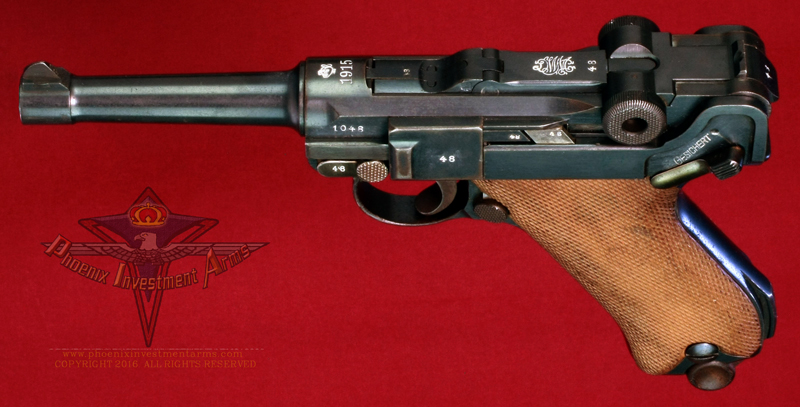 |
|
This is an excellent example of the all-matching dated 1915 Parabellum that was produced after the armistice and before the Allied Commission prevented the 9mm and 100mm barrel from production with the "Death Head" for an old collection. The term "rare""is over used in the gun descriptions but this one represents a direct connection to the Freikorps or Werewolf units that function after WWI. A jewel. Sorry but this wonderful complete rig is SOLD! |
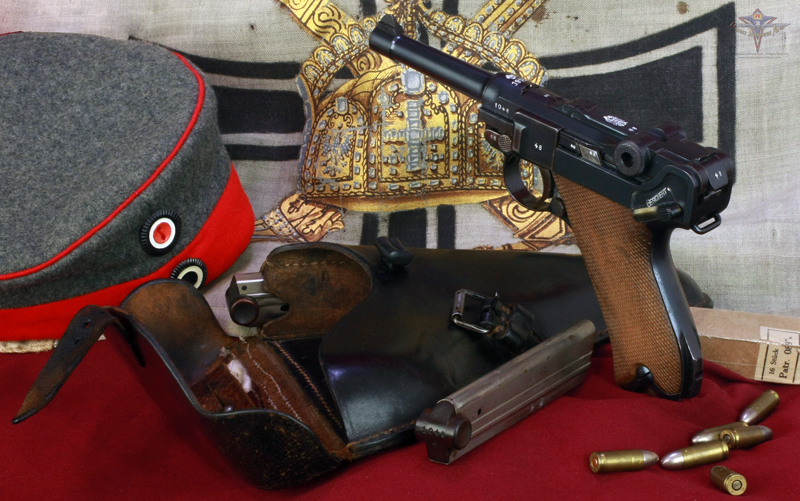 |
We reserve the right to sell any internet
offering to a direct sale and do not warrant the availability of
any firearm that do not have a cash deposit. This gun may be withdrawn without notice for in-store sale. Call for availability. Any questions or request for additional pictures email to josef@phoenixinvestmentarms.com. |
Home | New Additions | 1900-06 | WWI Imperial | Carbines | Artillery | Imperial Navy | Police Models | Archived Lugers | Accessories
Sell Your Gun | Notices | Good Info (C&R) | Ordering | Contact Us | Gun Shows | Legal Stuff | Testimonials | Notices | Holsters | Books
Top of Page
LAYAWAYS: Sometimes our "significant other" doesn't understand the beauty, craftsmanship and investment potential of one of these investor grade weapons. In these circumstances where discretion becomes the better part of valor we will accept layaways of up to one year with at least 20% down and some activity occurring monthly to insure that after one year the sale is completed. Cancellations of layaways forfeit 33% if done within two months, otherwise 100%. You can transfer a layaway to a consignment sale at any time. See "Legal" for exact terms. |
|
3 Day Return Policy We honor a three day return policy. We will answer any questions, send you any pictures, as detailed as you want, to insure that what we are showing you is what you want to see, before you buy it. See Legal. |
||
|

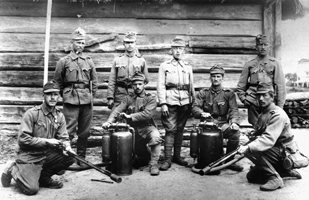 The bottom of the gun is clean showing the serial number under the barrel and that includes the magazine bottom. Also revealed is the Crown N which is the commercial proof.
The bottom of the gun is clean showing the serial number under the barrel and that includes the magazine bottom. Also revealed is the Crown N which is the commercial proof. 